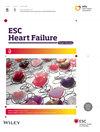在Impella 5.5支持下等待心脏和肾脏移植患者的中期生存率。
摘要
背景:由于肾脏替代疗法(RRTs)和多器官衰竭相关的风险,需要双器官移植(DOT)的终末期心力衰竭和慢性肾脏疾病患者在使用持久的机械循环支持方面面临重大挑战。鉴于该患者群体的长期支持选择有限,仍然迫切需要替代策略来优化终器官功能并使患者安全地进行移植。由于DOT的等待时间延长,我们展示了我们使用Impella 5.5作为临时机械循环支持的经验,证明了它在这一复杂队列中提供血液动力学稳定性和支持作为移植(BTT)桥梁的潜力。方法:对2019年12月至2022年11月在佛罗里达州梅奥诊所(Mayo Clinic)接受单器官移植或DOT治疗的所有患者进行单中心回顾性研究,采用Impella 5.5作为BTT进行支持。该分析的重点是需要RRT或列入心脏/肾脏移植的患者。在机构审查委员会批准为回顾性数据收集的豁免状态后,从基线和移植治疗期间的电子健康记录中提取数据。结果:共有41例患者得到Impella 5.5的支持,拟作为BTT。所有患者均成功移植。我们重点研究了10例采用Impella支持的DOT患者。在DOT组中,移植的中位年龄为63岁(59-66岁),男性9名,女性1名。基线中位射血分数为19%(15-22),白种人占50%,非裔美国人占50%,缺血性和非缺血性病因的平均分布。中位体重指数为30 kg/m2(26-31), 60%为o型血。DOT患者等待治疗的中位时间为53天(29-75)。DOT Impella患者围手术期管理显示基线血流动力学RA为11 mmHg(7-16),平均PA为36 mmHg (32-47), PCWP为29 mmHg(21-35),混合静脉饱和度(SVO2%)为51 (46-61),Fick CI为2.03 L/min/m2(1.66-2.5)。impella放置后血流动力学显示RA压力显著改善至5mmhg (4-8), P = 0.02, SVO2显著改善至70% (65-72),P = 0.002, Fick CI显著改善至5.5 (5.2-8),P = 0.03。平均支持时间为44天(范围10-94天)。基线时肾小球滤过率中位数为27 mmol/L(16-29)。24小时尿蛋白平均为168 mg/24 h(范围87-328),24小时肌酐清除率为29 mg/24 h(范围24-35)。10例患者中有8例在DOT前需要连续或间歇RRT。RRT(包括Impella支持)的中位总持续时间为36天(9-72天)。DOT接受者的1年生存率为90%,平均随访时间为432天。结论:我们的研究结果表明,长期使用Impella 5.5为等待双器官移植的终末期心脏和肾脏衰竭患者提供安全有效的血流动力学支持。1年生存率为90%,我们的数据表明,Impella 5.5可以成为传统支持策略的可行替代方案,特别是对于那些受到RRTs限制的患者。随着双器官移植变得越来越普遍,Impella 5.5为移植提供了一个有希望的桥梁,改善了这一复杂患者群体的短期和长期结果。Background: Patients with end-stage heart failure and chronic kidney disease requiring dual-organ transplantation (DOT) face significant challenges in utilizing durable mechanical circulatory support due to the risks associated with renal replacement therapies (RRTs) and multi-organ failure. Given the limited options available for long-term support in this patient population, there remains a critical need for alternative strategies to optimize end-organ function and bridge patients safely to transplant. With prolonged waitlist times for DOT, we present our experience with the Impella 5.5 as temporary mechanical circulatory support, demonstrating its potential to provide hemodynamic stability and support as a bridge to transplantation (BTT) in this complex cohort.
Methods: A single-centre retrospective review was completed of all patients listed for single-organ transplantation or DOT between December 2019 and November 2022 at Mayo Clinic in Florida, supported by the Impella 5.5 intended as BTT. The focus of this analysis was patients requiring RRT or listed for heart/kidney transplantation. Data were extracted from the electronic health record at baseline and during their transplant episode of care after institutional review board approval as exempt status for retrospective data collection.
Results: A total of 41 patients were supported with Impella 5.5, intended as BTT. All patients underwent successful transplantation. We focus on the 10 patients with Impella support who underwent DOT. In the DOT group, the median age at transplantation was 63 years (59-66), with nine males and one female. The baseline median ejection fraction was 19% (15-22), with 50% Caucasian and 50% African American and an even split between ischaemic and non-ischaemic aetiology. Median body mass index was 30 kg/m2 (26-31), and 60% were in blood group O. The median time on the waitlist for DOT patients was 53 days (29-75). Perioperative management of DOT Impella patients demonstrated baseline haemodynamics of RA 11 mmHg (7-16), mean PA 36 mmHg (32-47), PCWP 29 mmHg (21-35), mixed venous saturation (SVO2%) 51 (46-61) and Fick CI 2.03 L/min/m2 (1.66-2.5). Post-Impella placement haemodynamics demonstrated significant improvements in RA pressure to 5 mmHg (4-8), P = 0.02, SVO2 to 70% (65-72), P = 0.002, and Fick CI to 5.5 (5.2-8), P = 0.03. The average duration of support was 44 days (range 10-94). The median glomerular filtration rate at baseline was 27 mmol/L (16-29). Twenty-four hour urine protein averaged 168 mg/24 h (range 87-328), with the 24 h creatinine clearance of 29 mg/24 h (range 24-35). Eight of the 10 patients required continuous or intermittent RRT before DOT. The median total duration of RRT (including Impella support) was 36 days (9-72). DOT recipients had a 1 year survival of 90%, with an average follow-up of 432 days.
Conclusions: Our findings demonstrate that prolonged use of the Impella 5.5 provides safe and effective haemodynamic support for patients with end-stage heart and kidney failure awaiting dual-organ transplantation. With a 1 year survival rate of 90%, our data suggest that Impella 5.5 can be a viable alternative to traditional support strategies, particularly in patients who are otherwise limited by RRTs. As dual-organ transplantation becomes more prevalent, the Impella 5.5 offers a promising bridge to transplant, improving both short-term and long-term outcomes in this complex patient population.

 求助内容:
求助内容: 应助结果提醒方式:
应助结果提醒方式:


